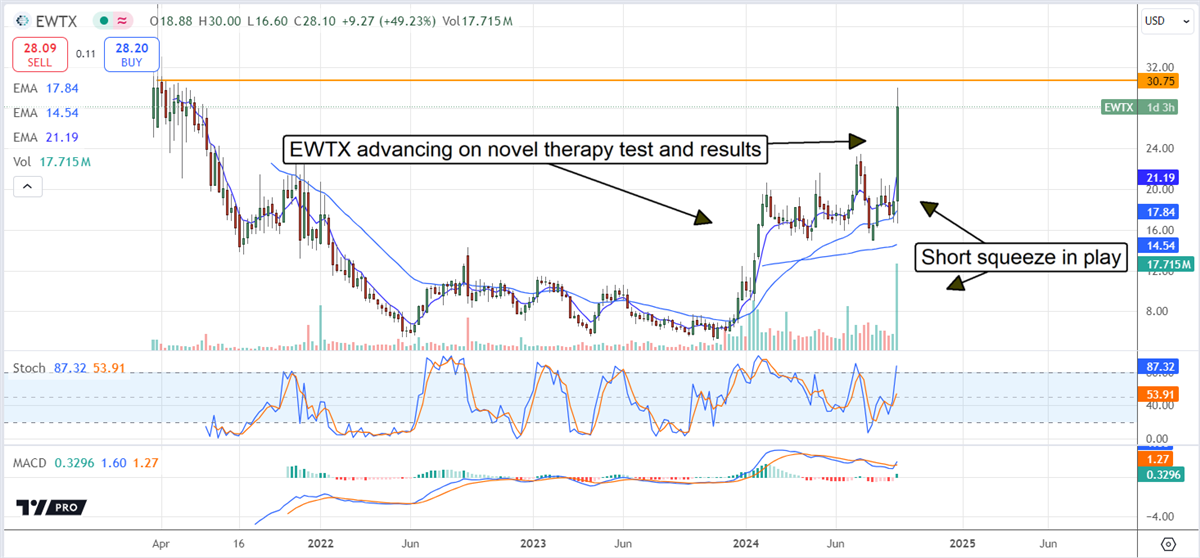Ticker Reports for September 19th
Edgewise Therapeutics Soars 50%: Key Reasons Behind the Surge
Edgewise Therapeutics (NASDAQ: EWTX) is up 50% in a single session and 450% from recent lows for a reason. Its novel, oral, selective treatment for obstructive hypertrophic cardiomyopathy did remarkably well in early trials. The news is important because hypertrophic cardiomyopathy or HCM for short, is the leading cause of sudden cardiac-related death in people under 35.
HCM is a genetic disease causing thickening in the heart muscle, an industry worth more than $1.25 billion today and growing. There are no current treatments of this caliber, with doctors relying heavily on beta-blockers and lifestyle changes. If approved, it will rocket this company from obscurity into the ranks of blockbuster treatments like GLP-1 blockers, which are revolutionizing weight control.
“There continues to be an unmet need for patients with obstructive and non-obstructive HCM, and we are excited to be part of the ongoing CIRRUS-HCM trial evaluating a novel treatment,” commented Anjali T. Owens, M.D., Medical Director, Center for Inherited Cardiac Disease, Associate Professor of Medicine, University of Pennsylvania and CIRRUS-HCM Investigator.
Sell-Side Interest Points to Higher Prices for Edgewise Therapeutics
After years of wallowing, Edgewise Therapeutics's share price action began to perk up this year as the news stream turned positive and sell-side interest was reinvigorated. The trend of price target reductions ended, and now the revisions are leading the market higher.
The consensus estimate reported by Marketbeat.com assumes at least a 15% upside from the $28 level, but revisions lead to the high-end range. Wedbush is among the few issuing revisions immediately after the news was released, raising its target by 42% to $44 and just shy of the high of $48. That was set by Piper Sandler earlier this year and implies a 70% upside is possible for this healthcare stock within the next twelve months.
Institutional activity is also bullish for this market. The institutional activity is robustly in favor of higher prices, surging to a record in Q2 and sustaining a solid pace in Q3. The takeaway is that institutions, private equity, and venture capital own about 90% of this stock and insiders another 4.5%, showing a high conviction in their support.
Short-Squeeze in Edgewise Therapeutics Means Volatility Ahead
Short interest is a factor in the share price surge. The short interest was nearly 15% in the last report and sufficient for a squeeze. Because EDG-700 is still in early trials and far from approval, the company is far from revenue and profits, and the short-sellers will likely reposition at a higher level and weigh on the market over the next few quarters. The good news is that volatility and short-sellers mean the share price will likely decline to retest for solid support. In that scenario, the stock could retreat to the $22 level or lower, opening a more attractive entry for investors.
Edgewise is Not a One-Trick Pony
Edgewise Therapeutics has an attractive, if small, pipeline of candidates in early stage 1 and stage 2 trials. They target individuals with Duchenne and Becker muscular dystrophy and have shown positive results to date. The next batch of results from these tests is expected in Q4 of this year and may provide another catalyst for the market. Regarding operations, the company reports losses due to its research and lack of revenue, but the losses are manageable, given the balance sheet. The company has over half a billion in cash, sufficient to sustain operations at recent levels for over 15 quarters.
The price chart of EWTX looks good. The market is recovering from its post-IPO blahs and appears to be in a full reversal. The price action is supported by increasingly high volume, so it has a high probability of continuing its advance. However, Investors should expect resistance to cap gains near the all-time highs until further developments are announced.

Tim Sykes' Urgent Trade Alert: "Make this move now"
WARNING: 80 Wall Street banks are gearing up for MASSIVE D.C. shock
This $2 trillion D.C. shock is NOT about Trump or Biden dropping out of the race…
How the Fed's Rate Cut Could Supercharge These 3 ETFs
With the Federal Open Market Committee (FOMC) cutting interest rates by a larger-than-expected 50 basis points in its September meeting, businesses throughout the country will be able to take out loans more cheaply. One intended goal of a rate cut like this is to foster increased profitability through business expansion. While many categories of stocks could theoretically benefit from a rate cut, some are better-positioned than others due to debt loads, links to consumer spending, and dividend structures.
Selecting individual names most likely to benefit from a rate cut can be difficult, so many investors mitigate risk and diversify their holdings by targeting exchange-traded funds (ETFs) instead. Some ETFs may provide a buffer against the possibility of a market slump due to concerns about cooling labor figures and the strength of the dollar.
IJR: Small-Caps Could Benefit From Easier Conditions, Lower Lending Costs
Small-cap stocks tend to be beneficiaries of rate cuts because of their reliance on floating-rate debt. Many of these companies do not have the balance sheets to be able to sustain operations and growth without taking on significant debt. However, reduced borrowing costs and easier financial conditions could help these companies, in particular, to expand their footprints. The small-cap-focused Russell 2000 has climbed by more than 22% in the last year in anticipation of a rate cut.
The iShares Core S&P Small-Cap ETF (NYSEARCA: IJR) holds a broad basket of more than 600 small-cap stocks, effectively managing some of the risk that is commonly associated with individual companies of this size. IJR also offers investors access to a variety of sectors for further diversification—likely a useful approach given post-rate cut sector rotation—as well as a low expense ratio of 0.06%.
VWO: Inflow Potential to Emerging Markets
When the FOMC cuts interest rates, it can help to ease the pressure on exchange rates for emerging markets. Lowered U.S. borrowing costs may also strengthen foreign capital inflows into these markets. The signals from the Federal Reserve that rate cuts were looming were enough to prompt Indonesia's central bank to cut its own rates before the FOMC's September meeting.
The Vanguard FTSE Emerging Markets ETF (NYSEARCA: VWO) offers a cheaper alternative to many other emerging markets funds as well as broad exposure to companies and sectors around the world. The fund's asset base and trading volume averages support both active trading and buy-and-hold investing styles. VWO is up more than 13% in the last year, which is shy of benchmarks like the S&P 500, although this may indicate that there is still growth potential in the emerging markets space that has not already been priced in.
PFFD: Capitalize on Strong Dividends
Preferred shares of companies tend to benefit alongside other stocks when interest rates fall. Add to this the potential for higher-than-usual dividends from these stocks, and they will become an even more attractive prospect following the Fed's rate cuts. High-dividend-yield stocks in interest-rate-sensitive industries also tend to carry large volumes of debt, so they too stand to benefit from an interest rate cut.
The Global X U.S. Preferred ETF (NYSEARCA: PFFD) holds more than 200 preferred stocks with a focus on utilities companies and banks, both of which stand to benefit from a more favorable low-interest rate scenario. PFFD also balances strong dividend payout with an expense ratio lower than some of its peers, helping to ensure that investors do not lose out on passive dividend income due to fund fees.
What Follows the Rate Cut?
A larger-than-expected rate cut could be a major boon to stocks across sectors, which could help to drive growth in each of the above ETFs. At the same time, investors should be mindful of the potential that an upfront rate cut combined with concerns about the labor market may spark a recession. This is why, despite the fact that many ETFs are designed to make investing easy for buy-and-hold investors, it may be worthwhile to take a more proactive approach to monitoring ETF performance in the weeks and months following the Fed's announcement to trim rates. On the other hand, if the rate cut has its intended effect and prompts a continued surge in the markets, these funds will position investors well to take advantage of those gains.
Brace yourself for what's coming next …
Legendary financial forecaster, Dr. Martin Weiss, has been warning us about it for months …
He believes the next incident could lead to people seeing their bank accounts frozen.
Microsoft Stock: 3 Reasons It's Ready to Crush Q4
Since powering to several all-time highs in June and July, shares of Microsoft Corp (NASDAQ: MSFT) have been struggling to regain momentum. Equities, in general, had a solid first half of the year, but interest rate jitters and a general softening of sentiment towards tech brought about some volatility, which is still being recovered from.
However, while scary at the start of last month, Microsoft’s juicy 17% drop is starting to look more and more like a healthy correction. The tech titan has been up more than 10% since then, with some bullish higher lows being set along the way.
As we start to round the corner into the year's final quarter, there are several reasons to think the latest phase of Microsoft’s multi-year rally has begun. Here are our top three.
1) Fundamental Performance
First up are Microsoft’s fundamentals, which are among the best in the business right now. Their most recently released numbers showed a record revenue for the business and its second highest EPS number. Both prints easily topped analyst expectations yet again, with the company’s cloud revenue, in particular, helping to underscore just how much potential Microsoft still has.
A slightly lowered forecast gave some cause for concern in the days following, and it didn’t help that the release coincided with the S&P 500’s worst week in years. However, the fact that Microsoft shares are already well above their pre-earnings price shows any negativity here has been factored in and forgotten about.
Don’t forget that Microsoft is a $3 trillion company, but it is still managing to grow total revenues year on year by more than 15% and certain units by as much as 20%. Off the back of such solid fundamentals, this week has already seen the company boost its dividend and authorize a $60 billion buyback of shares, two incredibly bullish actions to take that indicate management’s optimism about the years ahead.
These are all actions and growth trends that many of Microsoft’s tech peers would love to have. And with the Fed just now starting to cut rates, making it cheaper for growth stocks like Microsoft to borrow, we can expect this trend to continue.
2) Bullish Analysts
The second reason to be excited about Microsoft is the sheer number of analysts who are bullish on the stock. Since the company released its last earnings report, Wells Fargo, UBS Group, and Wedbush have all reiterated their Buy or Overweight ratings on the stock, along with price targets that are all above $500.
The latter specifically highlighted Microsoft this week in a list of companies that they consider to be especially well-positioned to benefit from the Fed’s rate cut and its knock-on effect for AI. This week, the team at Morgan Stanley reiterated their overweight rating on Microsoft shares, with analyst Keith Weiss highlighting what he called “an attractive risk/reward” profile.
His $506 price target for Microsoft speaks for itself, too. Considering the stock closed at $430 last night, that’s pointing to a targeted upside of nearly 20%. If shares trended toward that level in the coming weeks, they’d have crushed July’s previous all-time high and would be in blue-sky territory.
3) Technical Setup
Another reason to like Microsoft is the technical setup of the stock right now. Since hitting a hard low at the start of August, it hasn’t even looked like it wanted to test it again. Shares have essentially only trended up, while setting higher lows on the way. This is an indication of strong underlying support and shows that the bulls are firmly in control.
Investors thinking about getting involved should look for shares to stay above $410 on any pullback from here, with a move above $440 likely indicating the stock is ready to start testing July’s all time high.






0 Response to "🌟 How the Fed’s Rate Cut Could Supercharge These 3 ETFs"
Post a Comment